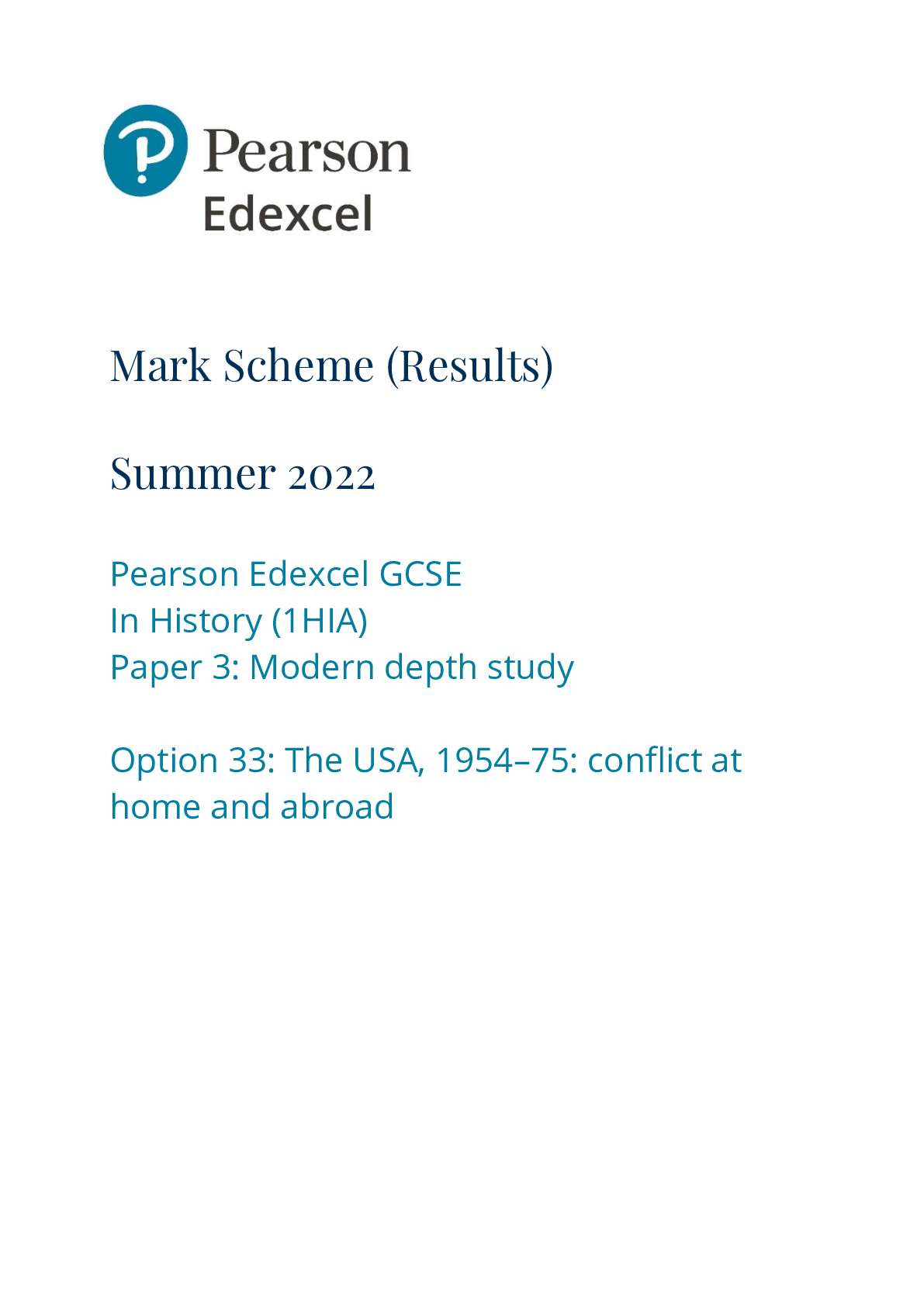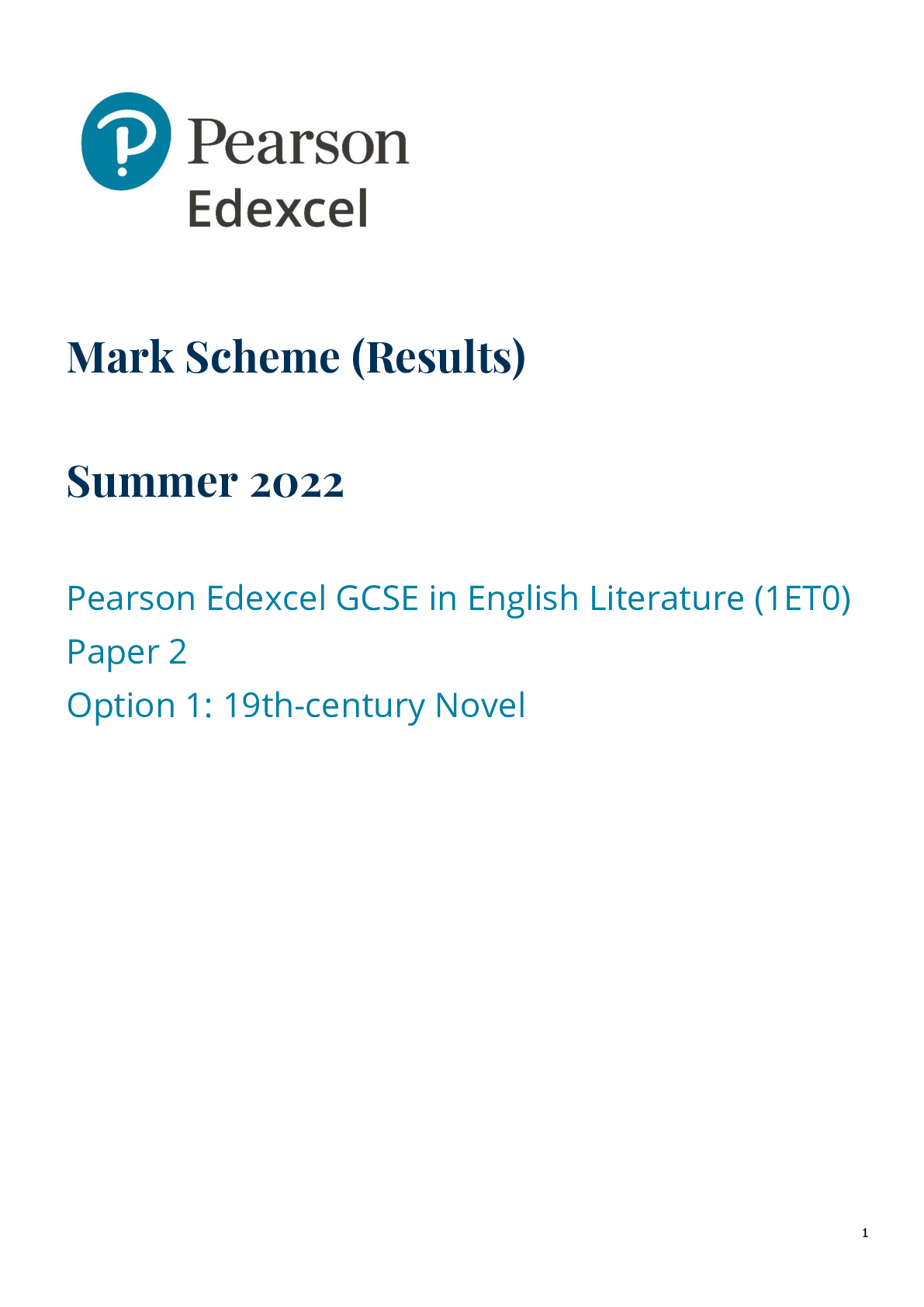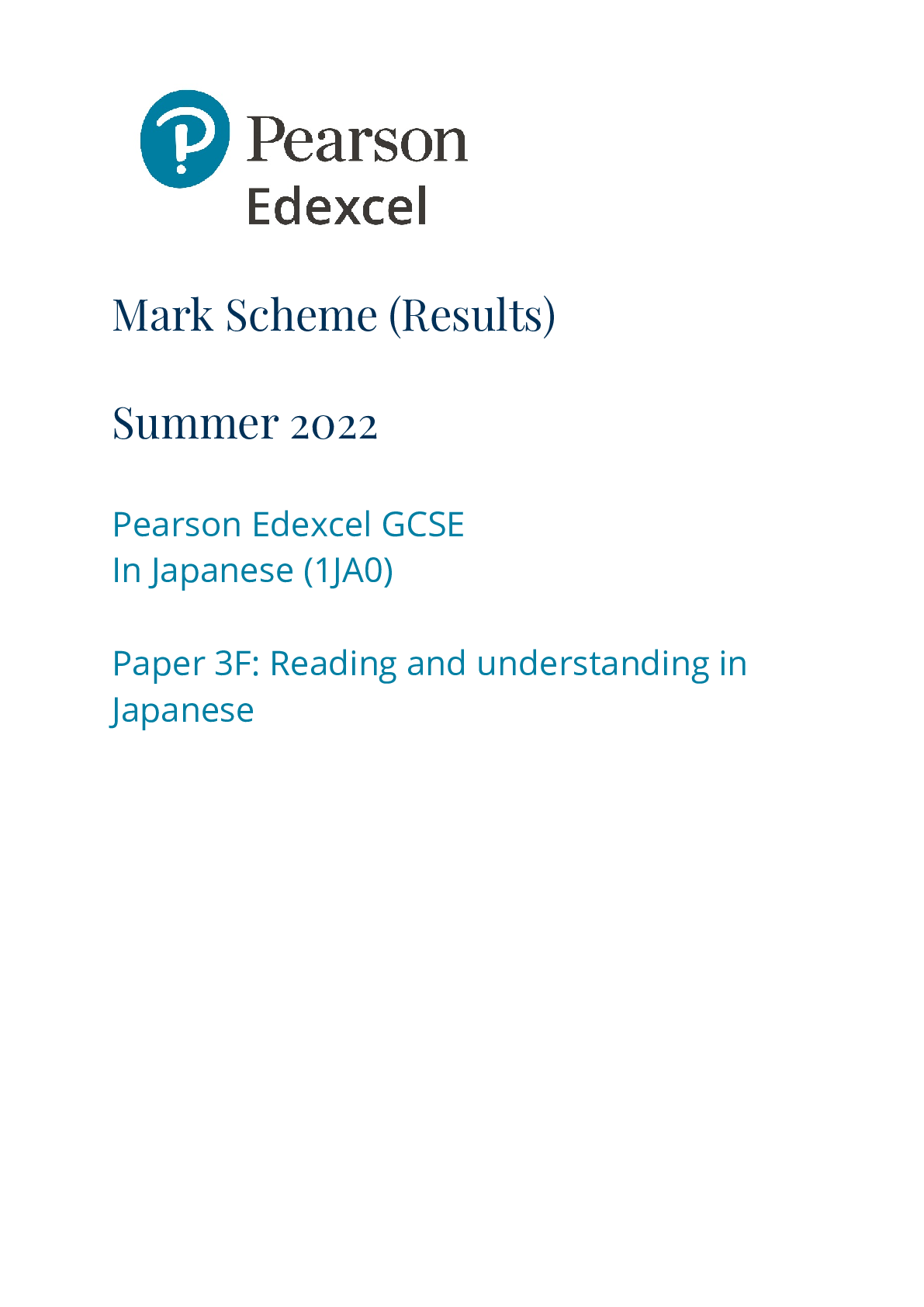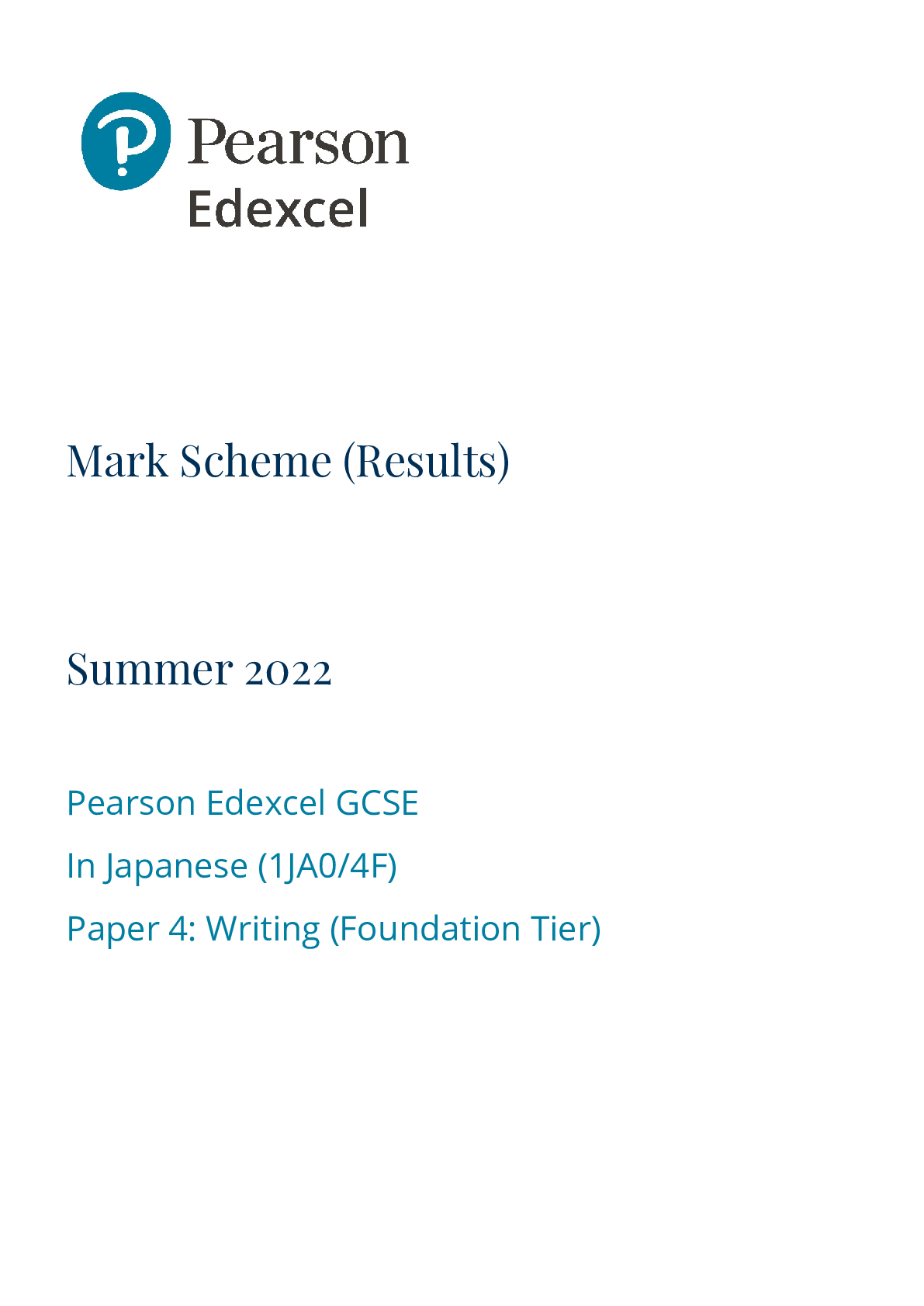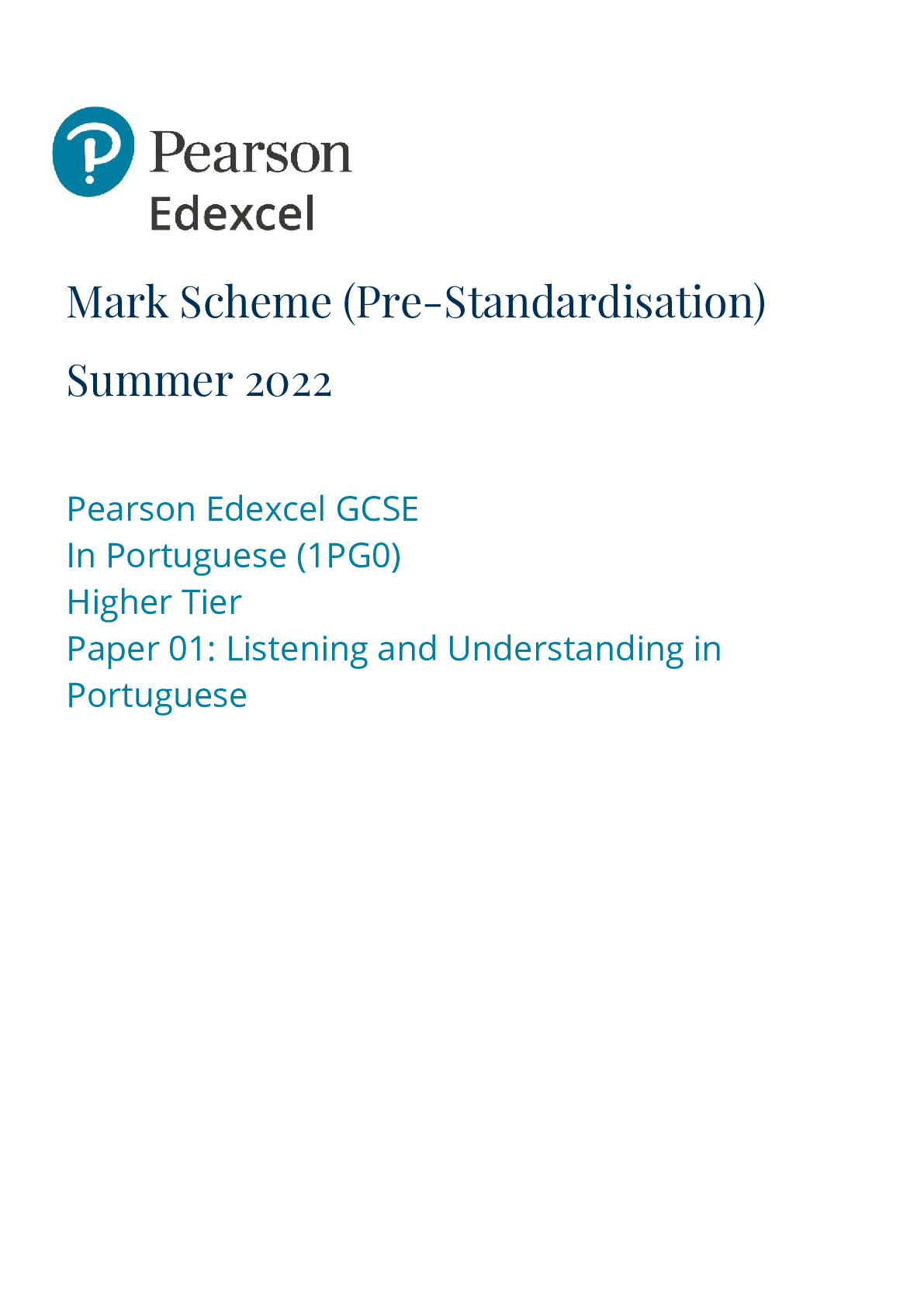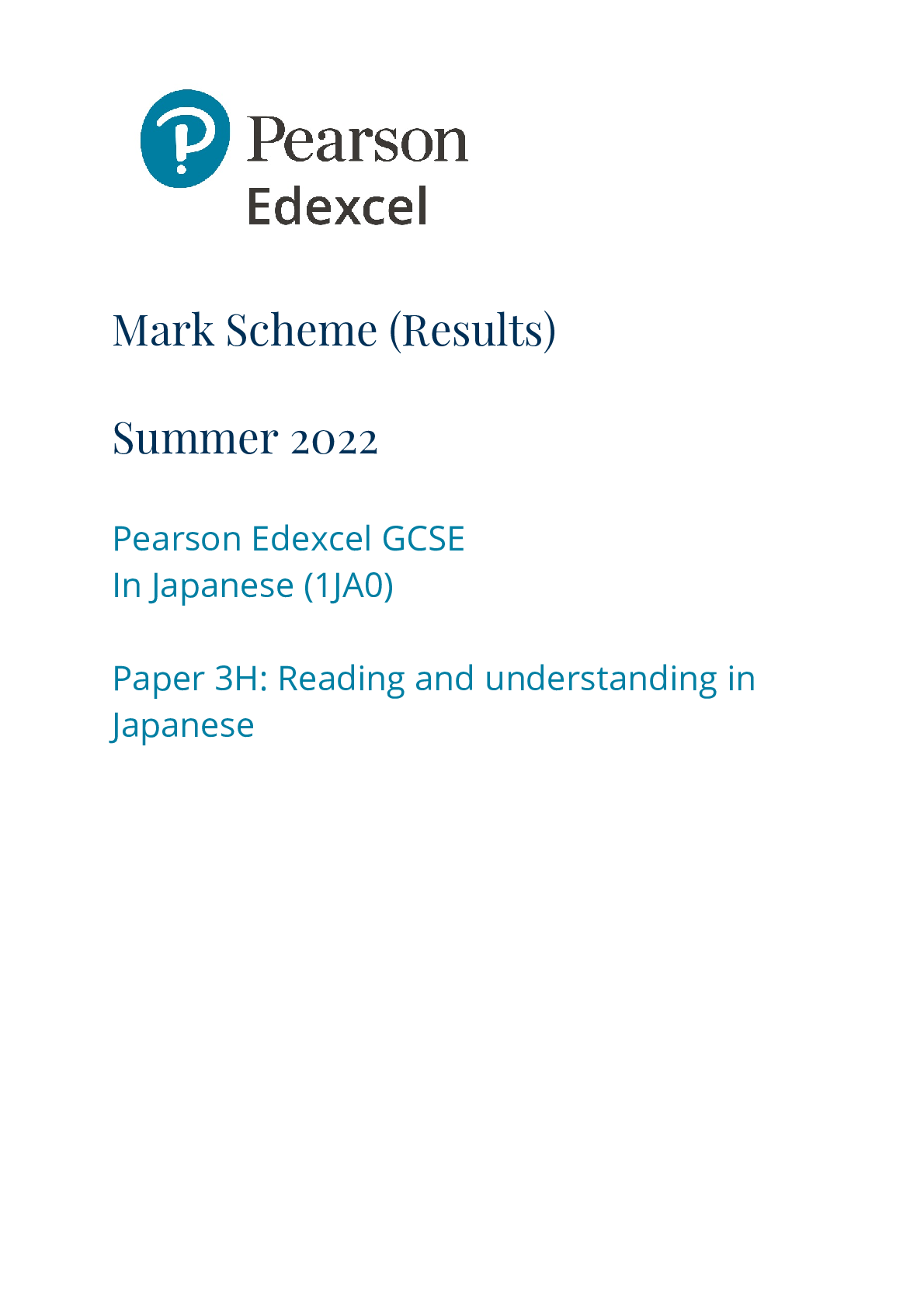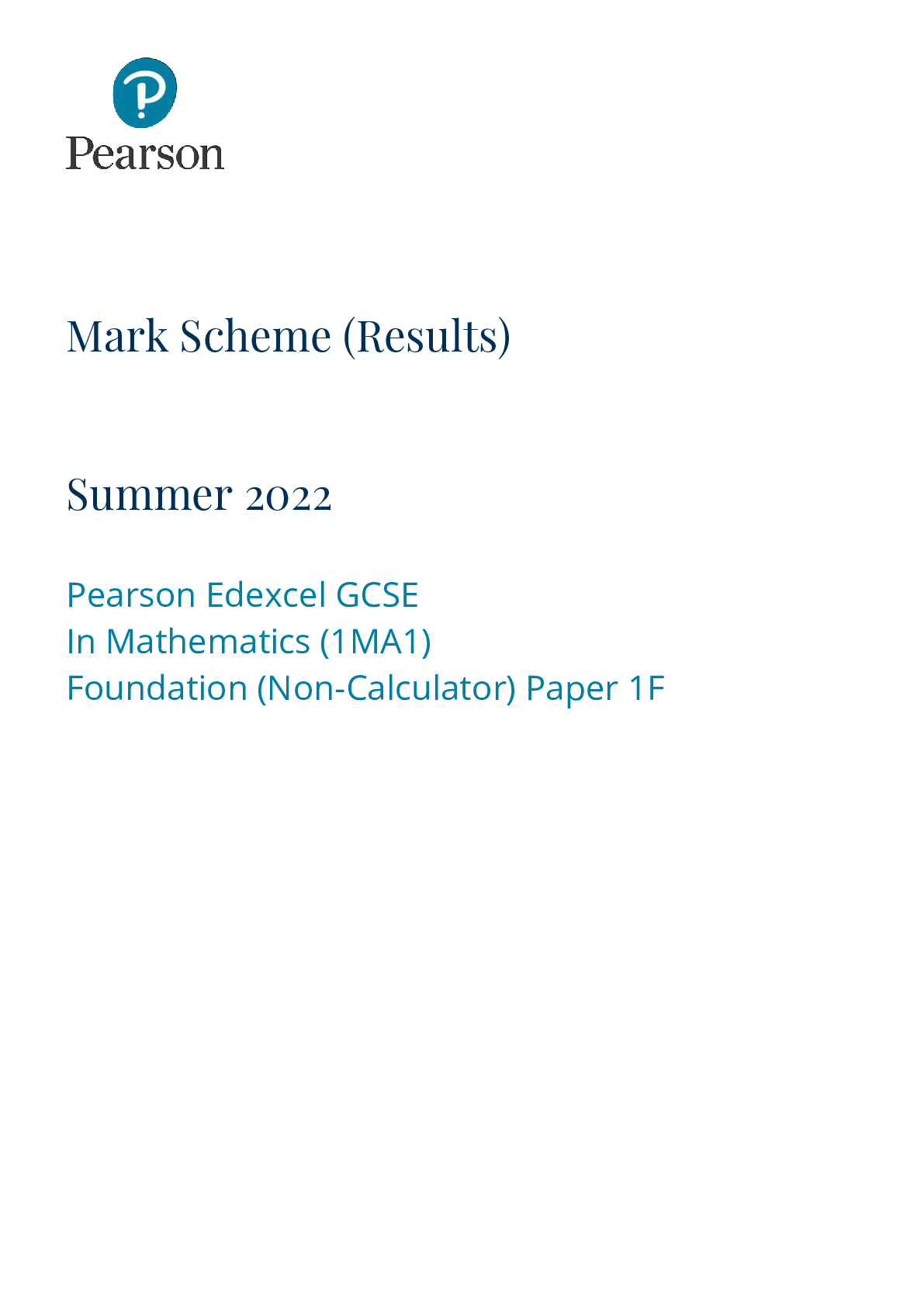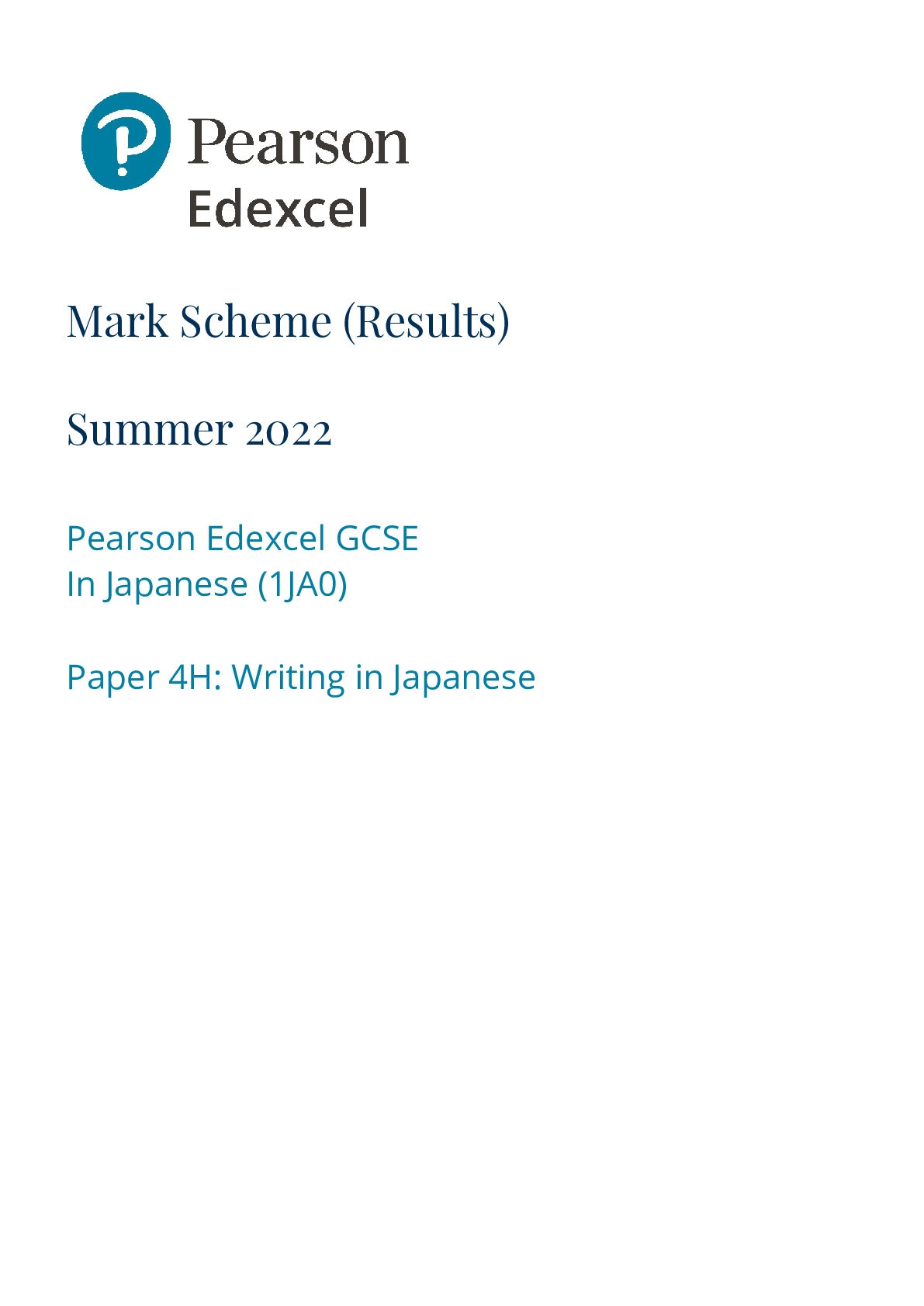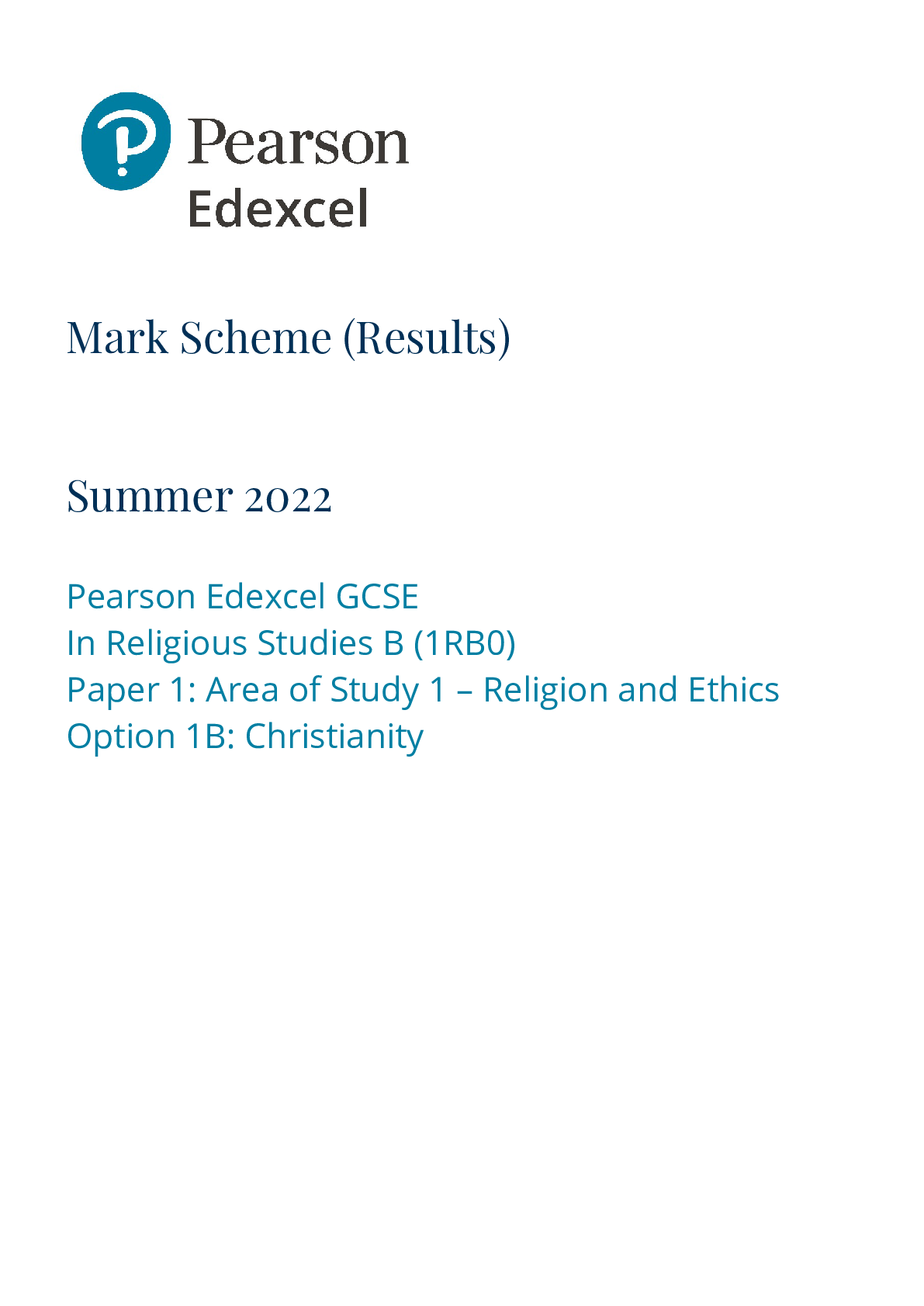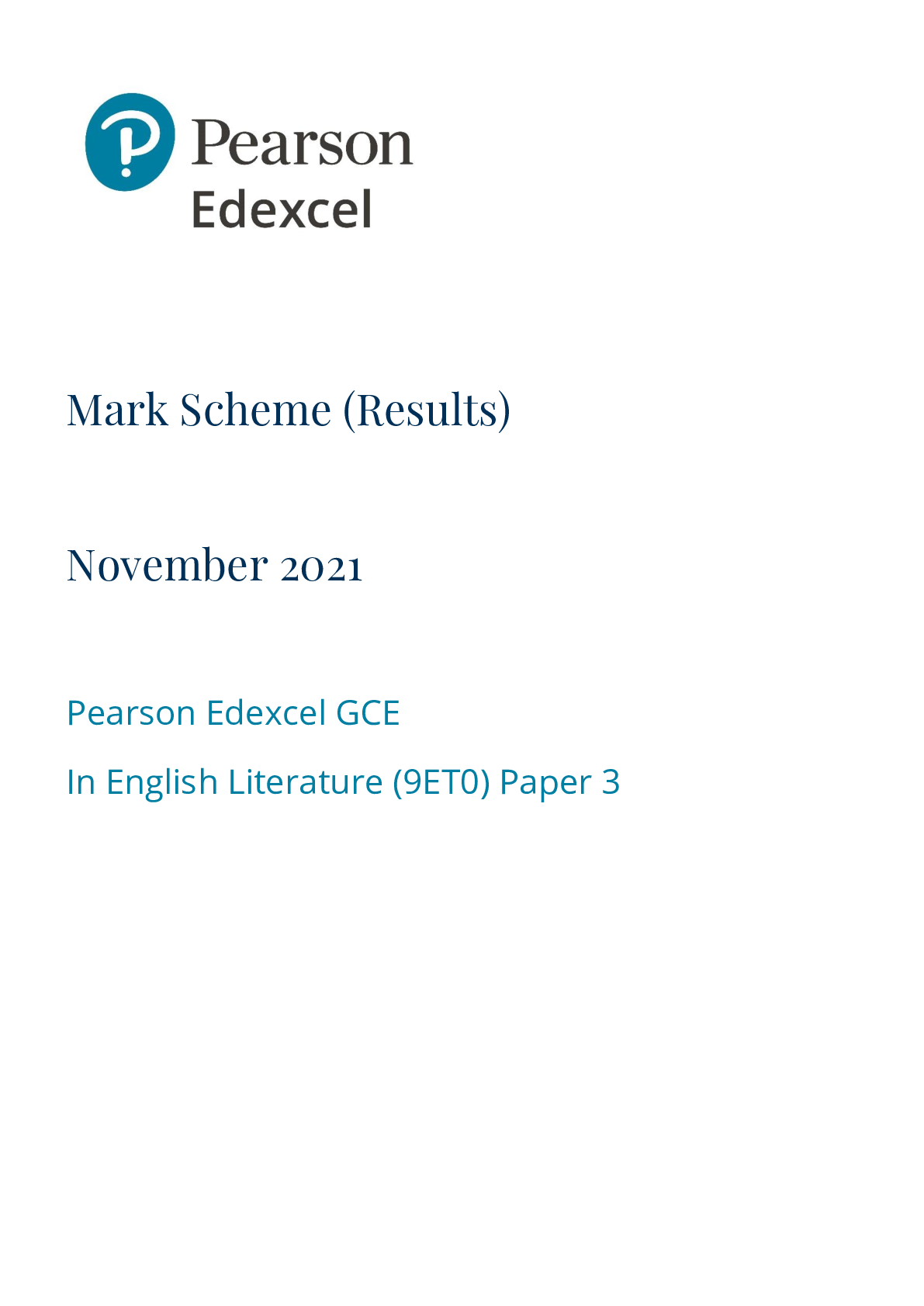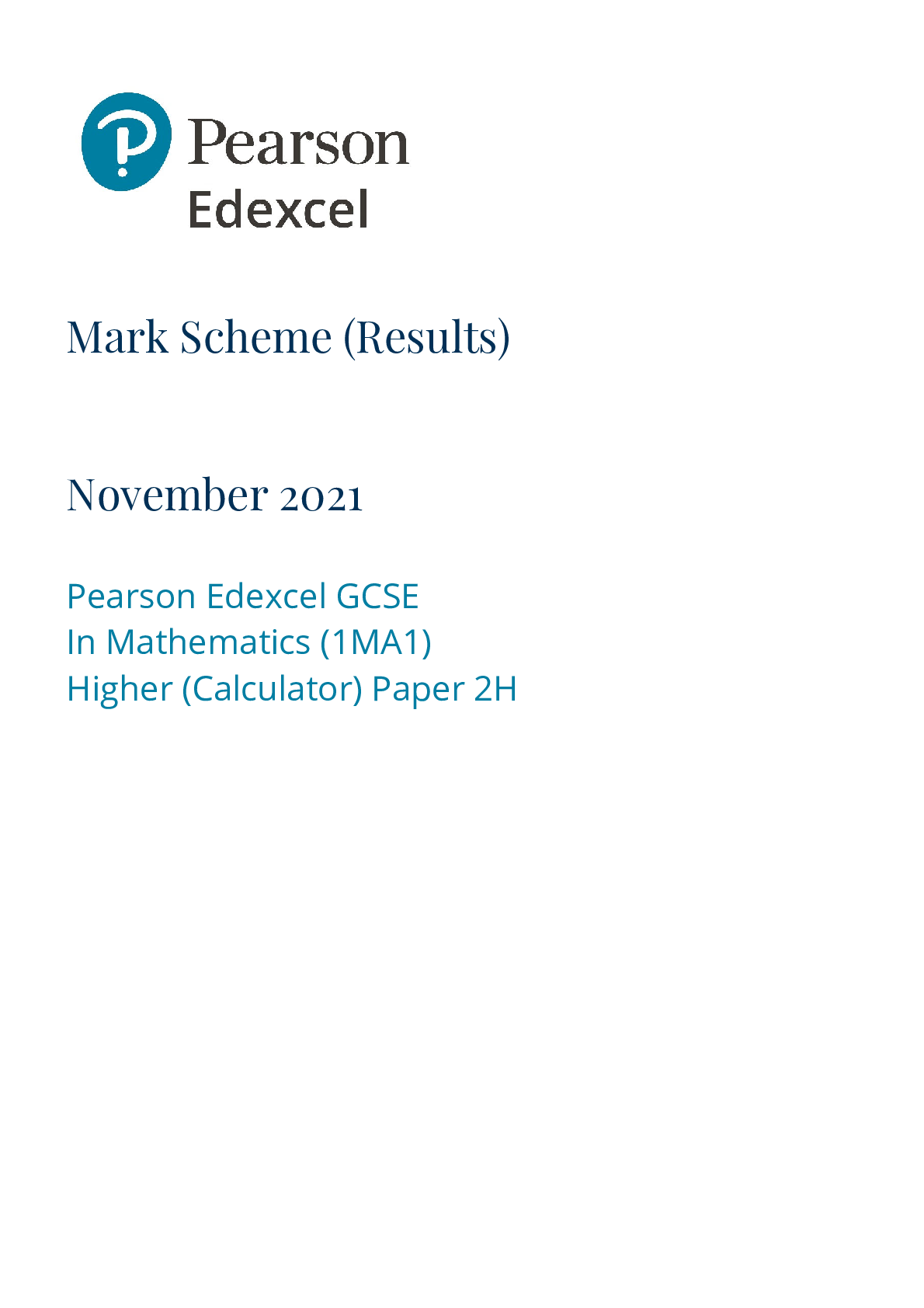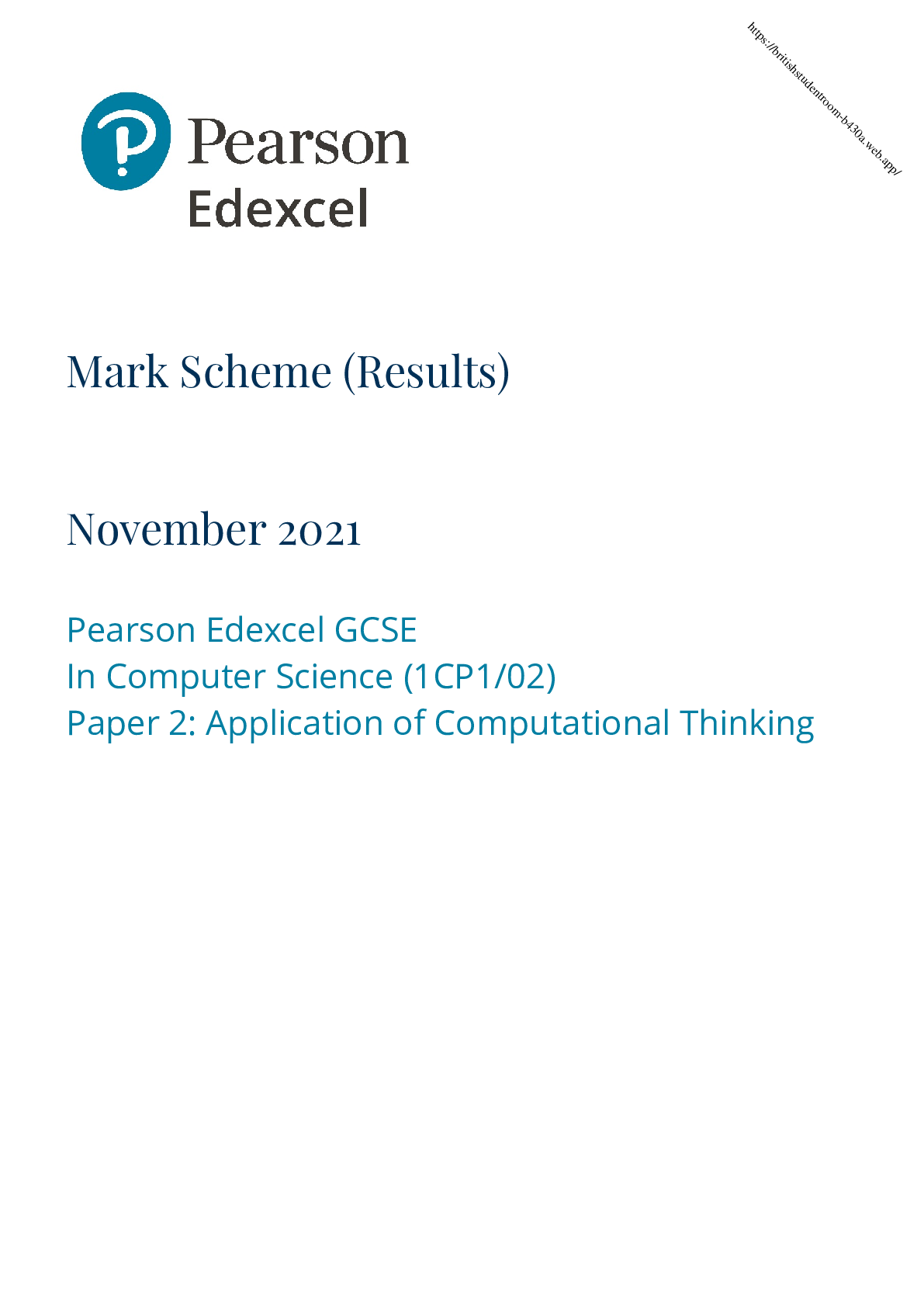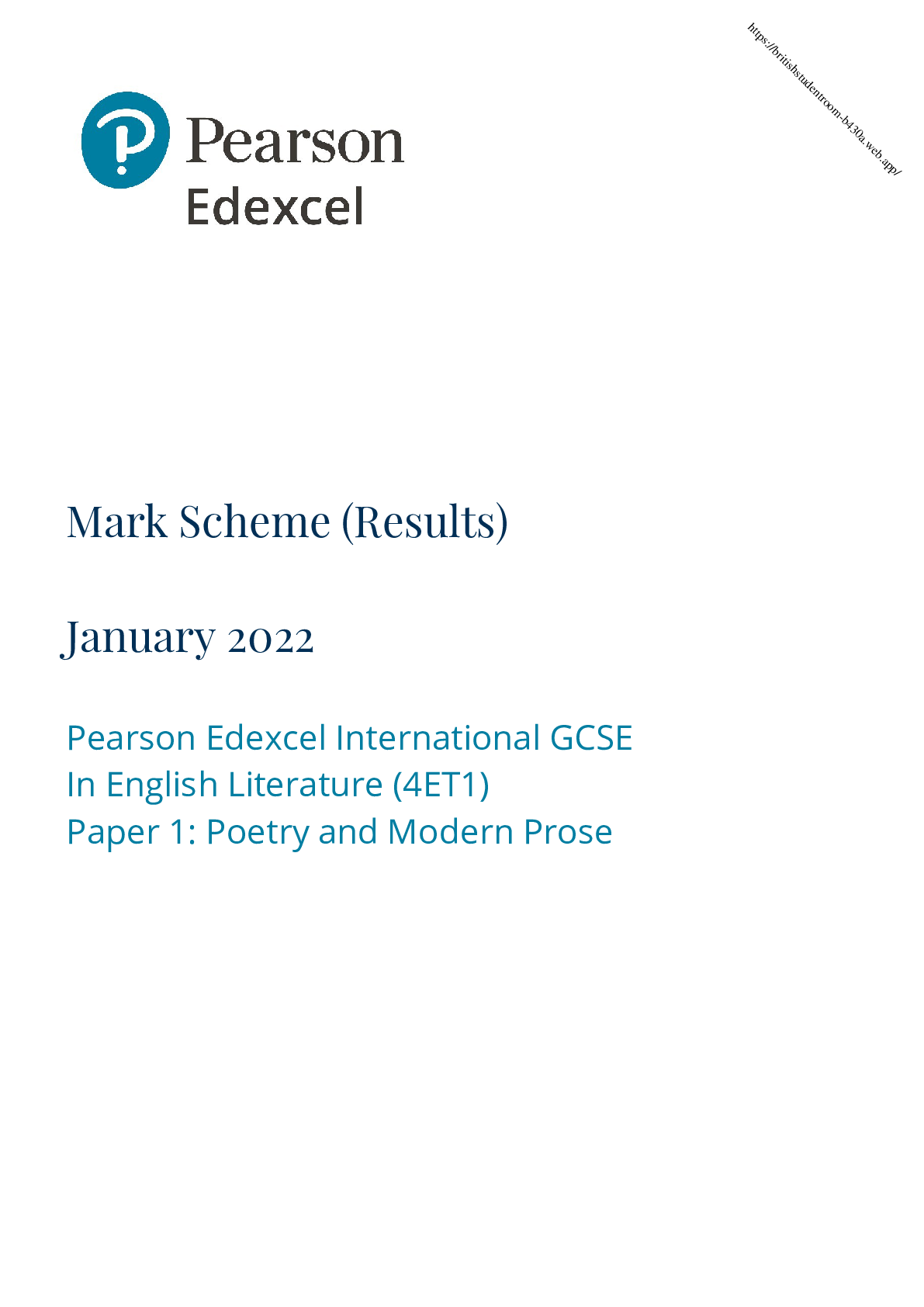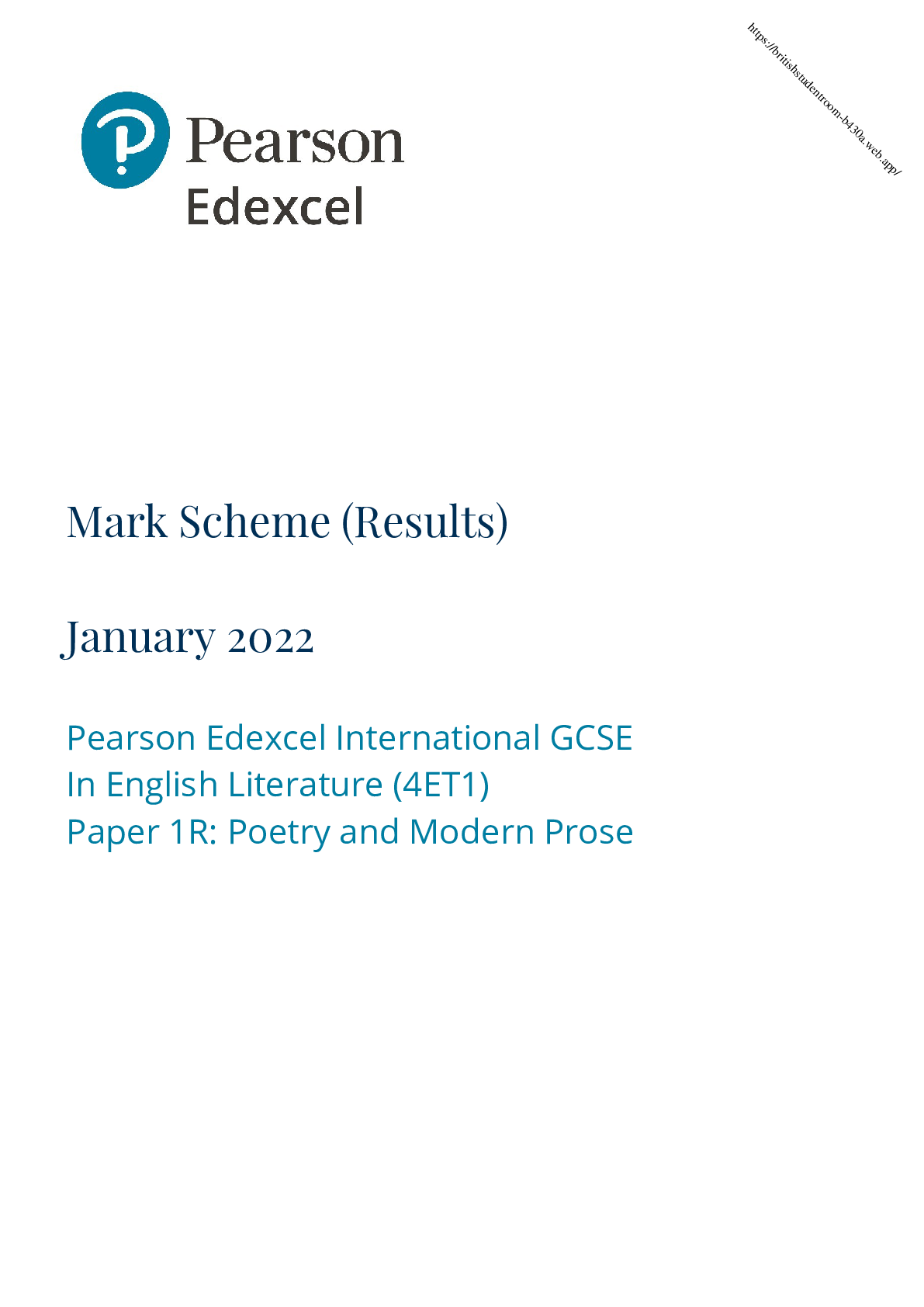English Literature > MARK SCHEME > Mark Scheme (Results) Summer 2022 Pearson Edexcel GCSE in English Literature (1ET0) Paper 2 Option 2 (All)
Mark Scheme (Results) Summer 2022 Pearson Edexcel GCSE in English Literature (1ET0) Paper 2 Option 2: Poetry since 1789
Document Content and Description Below
Mark Scheme (Results) Summer 2022 Pearson Edexcel GCSE in English Literature (1ET0) Paper 2 Option 2: Poetry since 1789 2 Edexcel and BTEC Qualifications Edexcel and BTEC qualificatio... ns are awarded by Pearson, the UK’s largest awarding body. We provide a wide range of qualifications including academic, vocational, occupational and specific programmes for employers. For further information visit our qualifications websites at www.edexcel.com or www.btec.co.uk. Alternatively, you can get in touch with us using the details on our contact us page at www.edexcel.com/contactus. Pearson: helping people progress, everywhere Pearson aspires to be the world’s leading learning company. Our aim is to help everyone progress in their lives through education. We believe in every kind of learning, for all kinds of people, wherever they are in the world. We’ve been involved in education for over 150 years, and by working across 70 countries, in 100 languages, we have built an international reputation for our commitment to high standards and raising achievement through innovation in education. Find out more about how we can help you and your students at: www.pearson.com/uk Summer 2022 Question Paper Log Number 73799 Publications Code 1ET0_2P_2206_MS All the material in this publication is copyright © Pearson Education Ltd 2022 3 General Marking Guidance • All candidates must receive the same treatment. Examiners must mark the first candidate in exactly the same way as they mark the last. • Mark schemes should be applied positively. Candidates must be rewarded for what they have shown they can do rather than penalised for omissions. • Examiners should mark according to the mark scheme not according to their perception of where the grade boundaries may lie. • There is no ceiling on achievement. All marks on the mark scheme should be used appropriately. • All the marks on the mark scheme are designed to be awarded. Examiners should always award full marks if deserved, i.e. if the answer matches the mark scheme. Examiners should also be prepared to award zero marks if the candidate’s response is not worthy of credit according to the mark scheme. • Where some judgement is required, mark schemes will provide the principles by which marks will be awarded and exemplification may be limited. • When examiners are in doubt regarding the application of the mark scheme to a candidate’s response, the team leader must be consulted. • Crossed out work should be marked UNLESS the candidate has replaced it with an alternative response. Marking Guidance – Specific • The marking grids have been designed to assess student work holistically. The grids identify the Assessment Objective being targeted by the level descriptors. • When deciding how to reward an answer, examiners should consult both the indicative content and the associated marking grid(s). When using a levels-based mark scheme, the ‘best fit’ approach should be used. • Examiners should first decide which descriptor most closely matches the answer and place it in that level. • The mark awarded within the level will be decided based on the quality of the answer and will be modified according to how securely all bullet points are displayed at that level. • In cases of uneven performance, the points above will still apply. Candidates will be placed in the level that best describes their answer according to the Assessment. Objective described in the level. Marks will be awarded towards the top or bottom of that level depending on how they have evidenced each of the descriptor bullet points. • Indicative content is exactly that – it consists of factual points that candidates are likely to use to construct their answer. It is possible for an answer to be constructed without mentioning some or all of these points, as long as they provide alternative responses to the indicative content that fulfil the requirements of the question. It is the examiner’s responsibility to apply their professional judgment to the candidate’s response in determining if the answer fulfils the requirements of the question. 4 Placing a mark within a level • Examiners should first decide which descriptor most closely matches the answer and place it in that level. The mark awarded within the level will be decided based on the quality of the answer and will be modified according to how securely all bullet points are displayed at that level. • In cases of uneven performance, the points above will still apply. Candidates will be placed in the level that best describes their answer according to the descriptors in that level. Marks will be awarded towards the top or bottom of that level depending on how they have evidenced each of the descriptor bullet points. • If the candidate’s answer meets the requirements fully, markers should be prepared to award full marks within the level. The top mark in the level is used for work that is as good as can realistically be expected within that level. The table below shows the number of raw marks allocated for each question in this mark scheme. Assessment Objectives Total Component AO1 AO2 AO3 AO4 mark Component2: Poetry Questions 1 to 4 15 5 20 Question 5 8 12 20 AO1 Read, understand and respond to texts. Students should be able to: ● maintain a critical style and develop an informed personal response ● use textual references, including quotations, to support and illustrate interpretations. AO2 Analyse the language, form and structure used by a writer to create meanings and effects, using relevant subject terminology where appropriate. AO3 Show understanding of the relationships between texts and the contexts in which they were written. AO4 Use a range of vocabulary and sentence structures for clarity, purpose and effect, with accurate spelling and punctuation. 5 Part 1 – Poetry Anthology In responses to Questions 1, 2, 3 and 4 examiners should be aware of the different ways candidates may structure their responses. There should be sufficient evidence of a response comparing the poems. Comparison is not directly associated with a discrete assessment objective. However, candidates must answer the question set, and provide sufficient evidence to meet the requirements of the assessment objectives through their comparison including the poets’ use of language, form and structure (AO2), and the contexts in which the poems were written (AO3). The coverage of the two poems need not be equally weighted but the second poem should have substantial treatment. Responses that are considerably unbalanced will not be able to access Level 3, where explanation of writers’ ideas and perspectives is required alongside a wide range of comparisons between texts. Examiners must reward all reasonable, valid points and comments that show an understanding and comparison of the two poems and all the requirements of the question. Candidates are free to select and comment on textual details in a variety of ways. They are not expected to deal with every possible point and may be rewarded for a comparatively small number of points if they are effectively developed and supported by well-chosen textual evidence. The following indicative content illustrates some points that candidates may make, but examiners should evaluate other responses on their merits, being alert to unusual comments that are well explained and substantiated. Question Indicative Content 6 Number 1 Relationships The indicative content is not prescriptive. Reward responses that explore how changes in relationships are presented in One Flesh and which compare this to a substantial extent with a second poem. Responses may include: One Flesh Form and structure (AO2): • the poem is written in three six-line stanzas that explore the changed relationship of the speaker’s elderly parents. The parents have become physically and emotionally distanced and the regular structure could reflect routine, possibly entrapment, or the monotony of the relationship • a sombre tone and the speaker’s despair are evident; there is tenderness for the parents and a sense of sadness as, in old age, passion between the parents appears to have been lost • the regular rhyming pattern perhaps suggests that the marriage is steady and full of routine, despite the changes. The deviation of rhyme in the last two lines perhaps reflects the more detached relationship • the use of caesura breaks the speaker’s different thoughts and observations and enhances the parents’ separation • dashes capture the awkwardness that has emerged in the relationship. The poet's language and ideas (AO2): • the title of the poem has religious connotations linked to the view of marriage in the Bible. This is later supported with the terms ‘confession’ and ‘Chastity’. ‘Chastity’ is personified, as if almost being a threat • the poem reflects how the parents have grown apart: ‘Lying apart now, each in a separate bed’ • the simile, ‘she like a girl dreaming of childhood’, suggests that the mother wants to return to a happier time. Both parents appear to wait for ‘Some new event’ • contrasts of light and dark add to the sombre tone and suggest that there could be similar years ahead: ‘keeping the light on late’, ‘shadows overhead’ • fricatives emphasise the bitterness: ‘Tossed up like flotsam from a former passion’. The noun ‘flotsam’ suggests that the marriage is broken or vulnerable • ‘former passion’ indicates that the relationship was once loving. ‘Passion’ and ‘fire’ juxtapose with the coldness that has now developed: ‘How cool they lie’, ‘grown cold’ • repetition of ‘Strangely’ emphasises how delicate the relationship has become • the comparison ‘like a thread’ suggests that the relationship is fragile, but a bond still exists between the parents • the metaphoric ‘time itself’s a feather’ further reflects the delicacy that has come with old age. 7 Context points (AO3) may be of various kinds and should relate to the poems and question. The following are examples, but there are many other possibilities: • the poem is personal and is about Jennings’ observations of her parents’ changed relationship • Jennings and her parents were devout Roman Catholics, where marriage is considered a life-long commitment and divorce seldom accepted. Elizabeth Jennings never married. • the poem, written in 1966, reflects a time when society became more permissive and open about relationships and sex • much of Jennings’ poetry focuses on spiritual and emotional topics, such as suffering, relationships, loneliness and religious faith. Reward all valid points. The second poem: For the second poem, candidates may choose ANY ONE other appropriate poem from the Relationships anthology collection for comparative treatment. The chosen poem must allow the candidate to explore changes in relationships in a relevant way. For example, if candidates choose the poem Neutral Tones by Thomas Hardy, they might make such points as the following but will be required to provide evidence of AO2 and AO3 in responses. (These are purely illustrative, since other poems may well be selected.) • Both poems are personal and explore changes in relationships. Neutral Tones is about the speaker’s changing relationship with a lover and One Flesh is about the changed relationship of the speaker’s parents. (AO2) • The poets use religious connotations and metaphors. (AO2) • Neutral Tones has a cyclical structure whereas One Flesh is linear. (AO2) • The poems both have a bitter, sombre tone. The changing relationship in Neutral Tones is final, whereas in One Flesh the parents remain together. (AO2) • Hardy was a Victorian realist and considered many beliefs about marriage, religion and education were constraining. Hardy wrote Neutral Tones in 1867 (first published in 1898), before his unhappy marriage to Emma. Jennings often included spiritual themes in her poems. Jennings never married. (AO3) 8 Level Mark (20 marks) Descriptor Bullet 1 (Comparison), Bullets 2, 3 and 4 (15 marks) – AO2, Bullet 5 – AO3 (5 marks) 0 No rewardable material. Level 1 1–4 • There is little or no comparison of the two poems. • Identification of form and structure is minimal. • There is little awareness of the language used by the poets. • Little evidence of relevant subject terminology. • There is little awareness of context and little comment on the relationship between poems and context. Level 2 5–8 • There are some underdeveloped comparisons and contrasts presented, with obvious similarities and/or differences, supported with some ideas from the poems. • There is some comment on the form and structure of the poems. • Some awareness of the poets’ use of language is shown, but without development. • Limited use of relevant subject terminology to support examples given. • There is some awareness of relevant context and some comment on the relationship between poems and context. NB: The mark awarded cannot progress beyond the top of Level 2 if only ONE poem has been considered. Level 3 9–12 • The response compares and contrasts a range of points and considers some similarities and/or differences between the poems. • The response shows a sound understanding of form and structure and links them to their effect. • There is clear awareness, with sound examples, of the poets’ use of language and of its effect on the reader. • Relevant subject terminology is used to support examples given. • There is sound comment on relevant context and sound relevant comment on the relationship between poems and context. Level 4 13–16 • The response compares and contrasts the poems effectively, considering a wide range of similarities and/or differences, and ideas are supported throughout with relevant examples from both poems. • Analysis of form and structure and their effect is sustained. • The candidate comments effectively on the poets’ use of language and its effect on the reader. • Relevant subject terminology is used accurately and appropriately to develop ideas. • There is sustained comment on relevant context and detailed awareness of the relationship between poems and context. 9 Level 5 17–20 • The writing is informed by perceptive comparisons and contrasts, with a varied and comprehensive range of similarities and/or differences between the poems considered. • There is perceptive grasp of form and structure and their effect. • The response offers a cohesive evaluation of the poets’ language and its effect on the reader. • Relevant subject terminology is integrated and precise. • There is excellent understanding of context, and convincing understanding of the relationship between poems and context is integrated into the respo [Show More]
Last updated: 1 year ago
Preview 1 out of 28 pages
Instant download
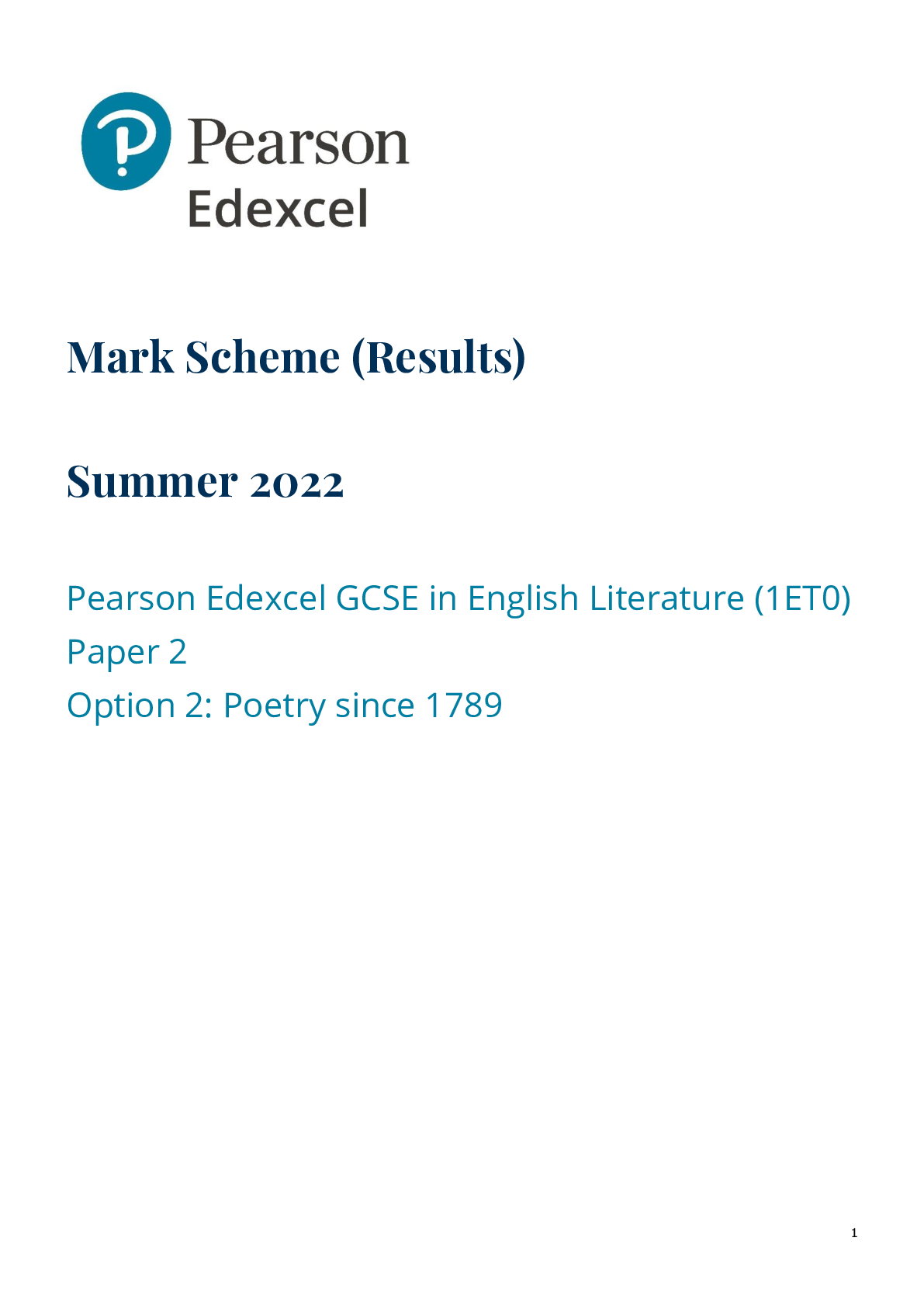
Buy this document to get the full access instantly
Instant Download Access after purchase
Add to cartInstant download
Reviews( 0 )
Document information
Connected school, study & course
About the document
Uploaded On
Apr 03, 2023
Number of pages
28
Written in
Additional information
This document has been written for:
Uploaded
Apr 03, 2023
Downloads
0
Views
75

